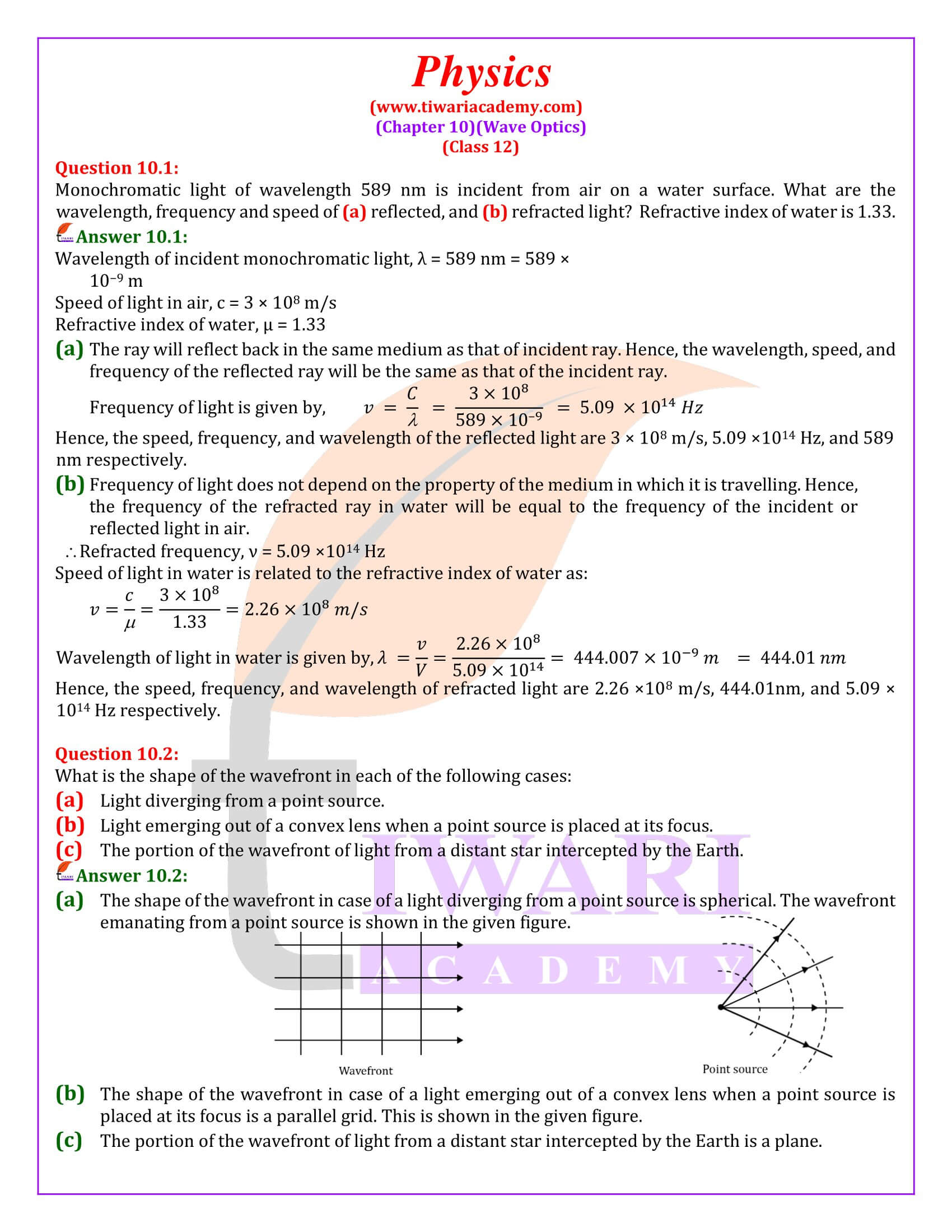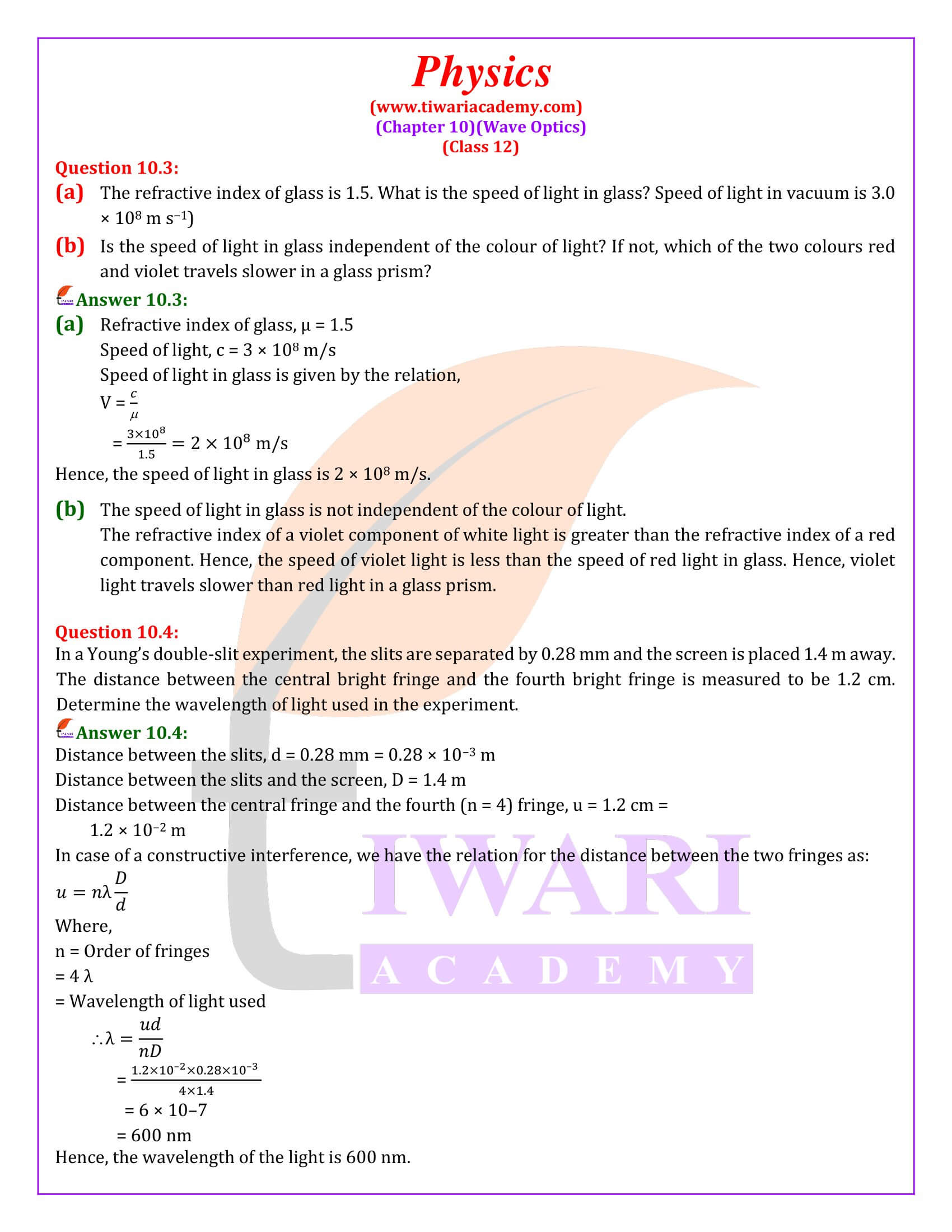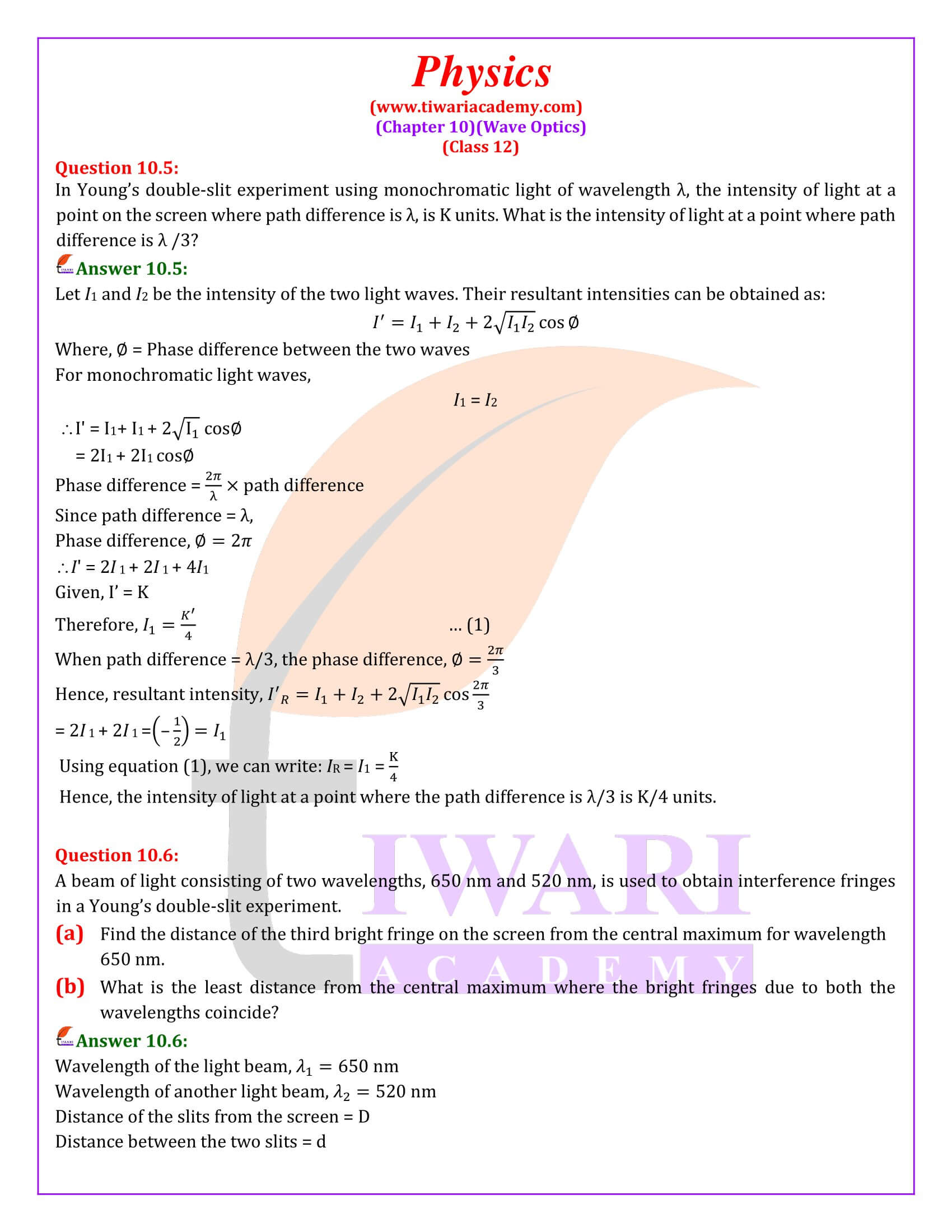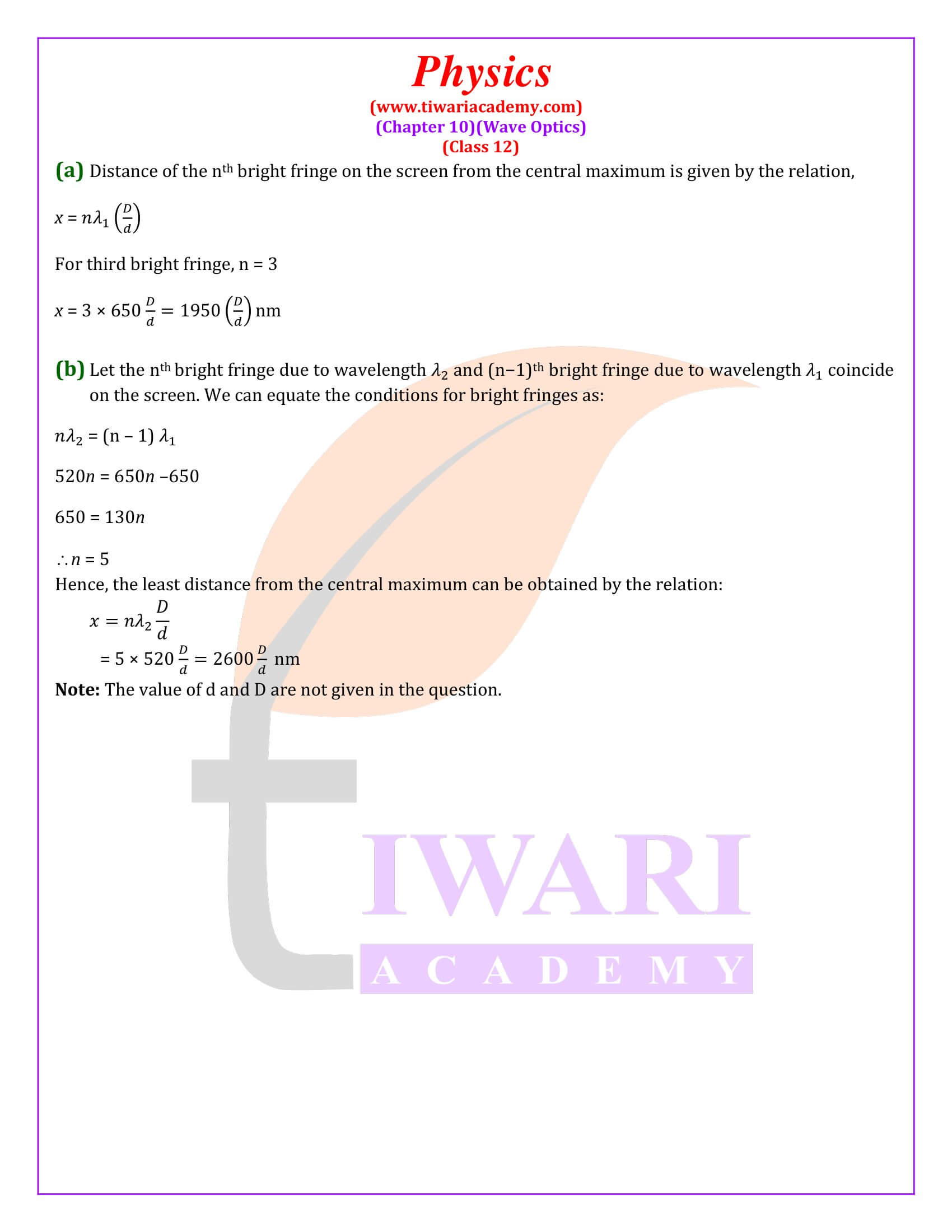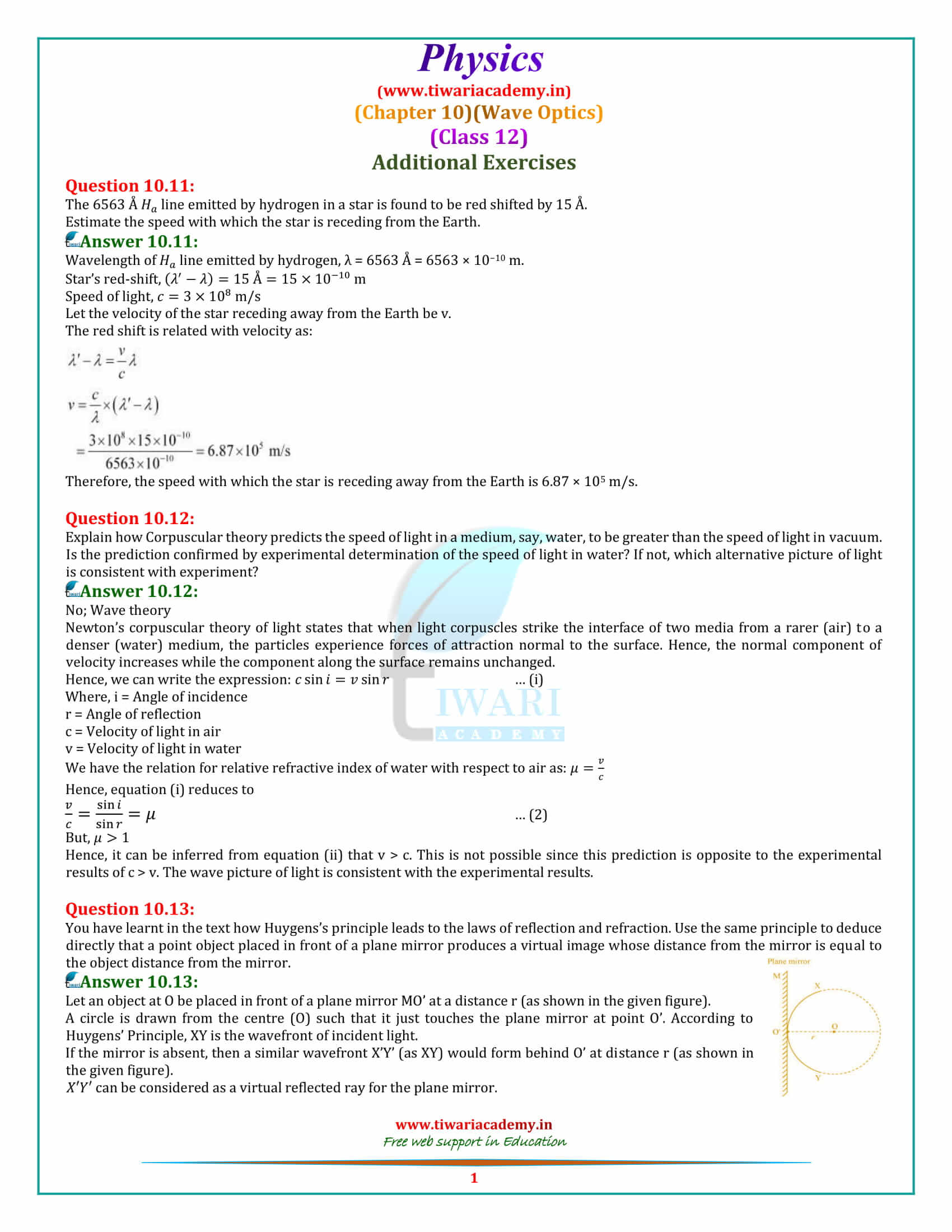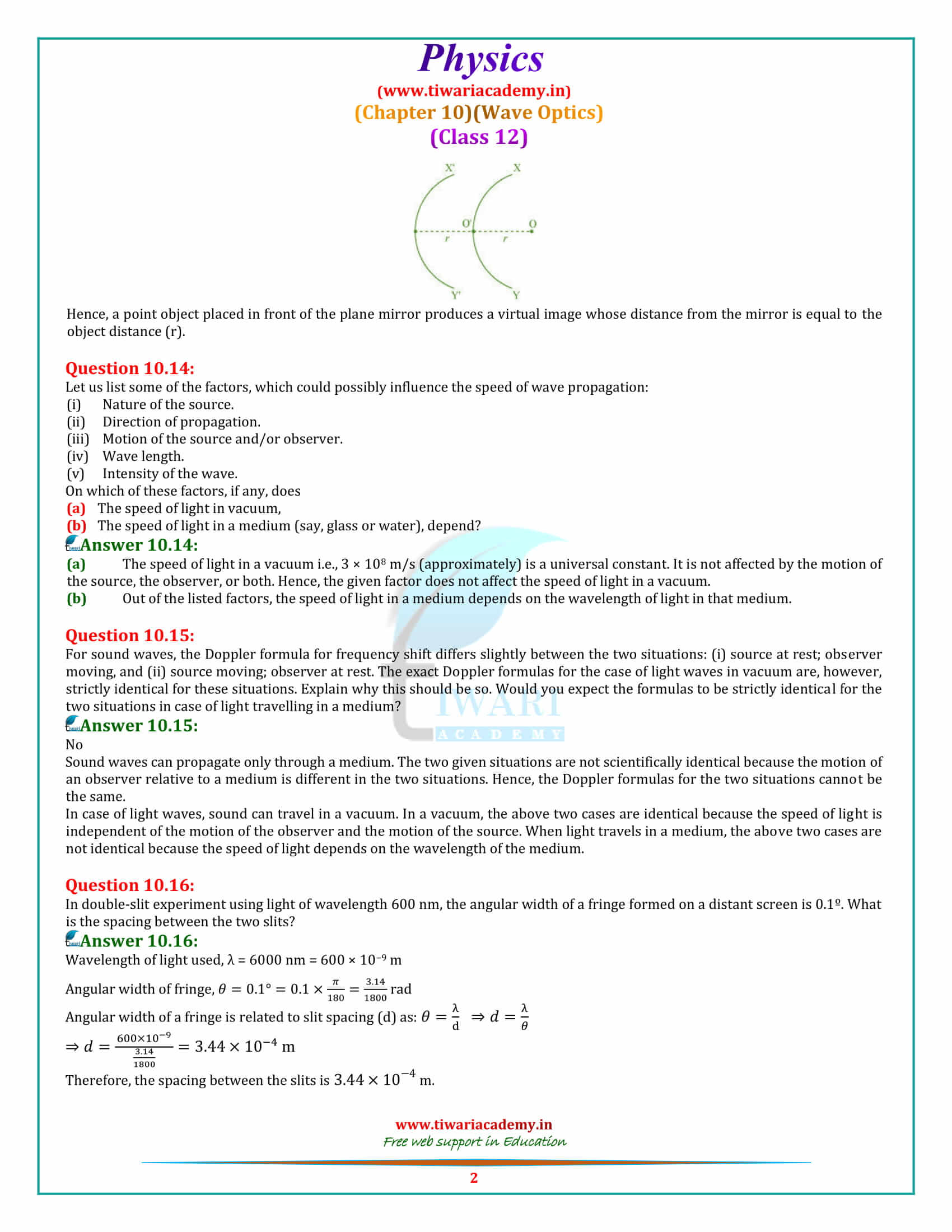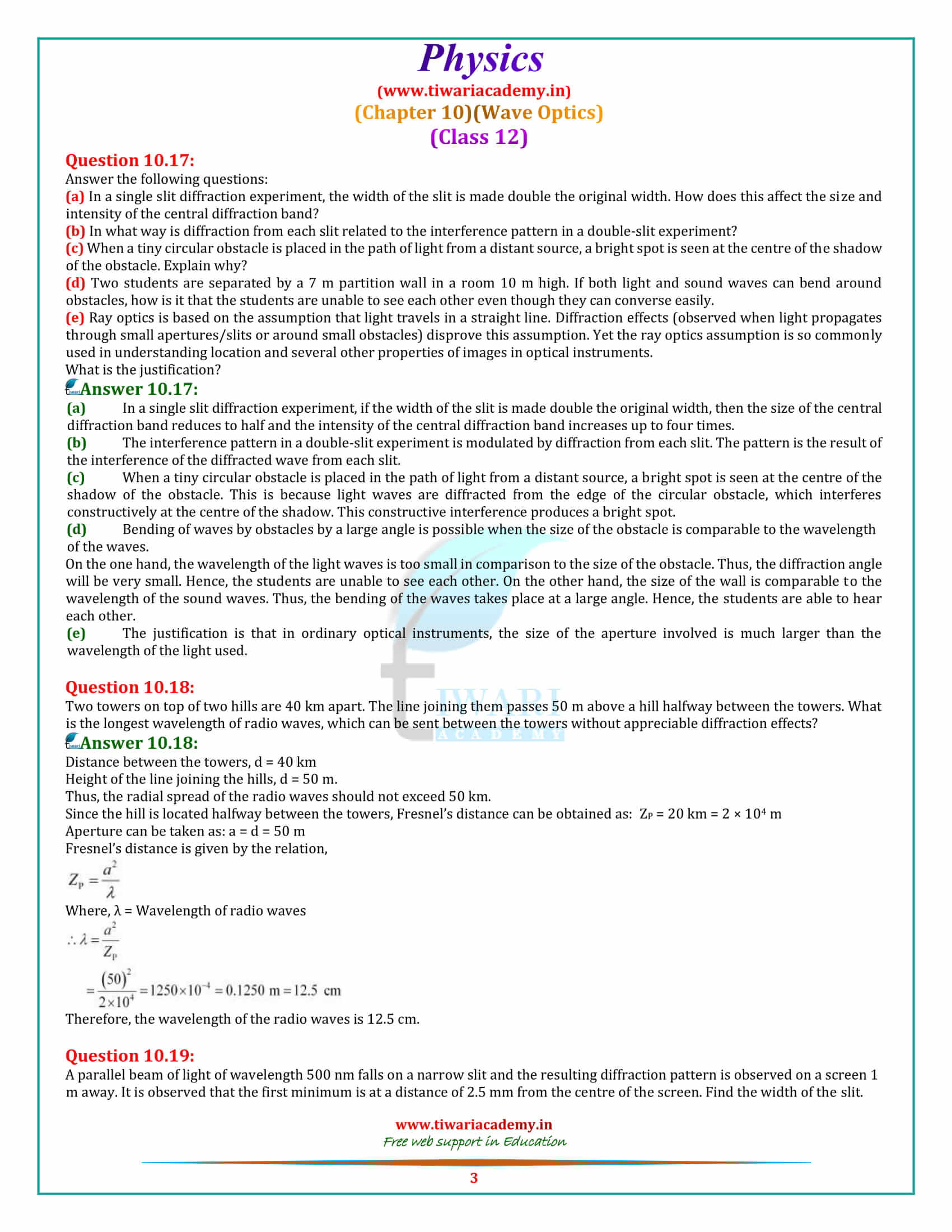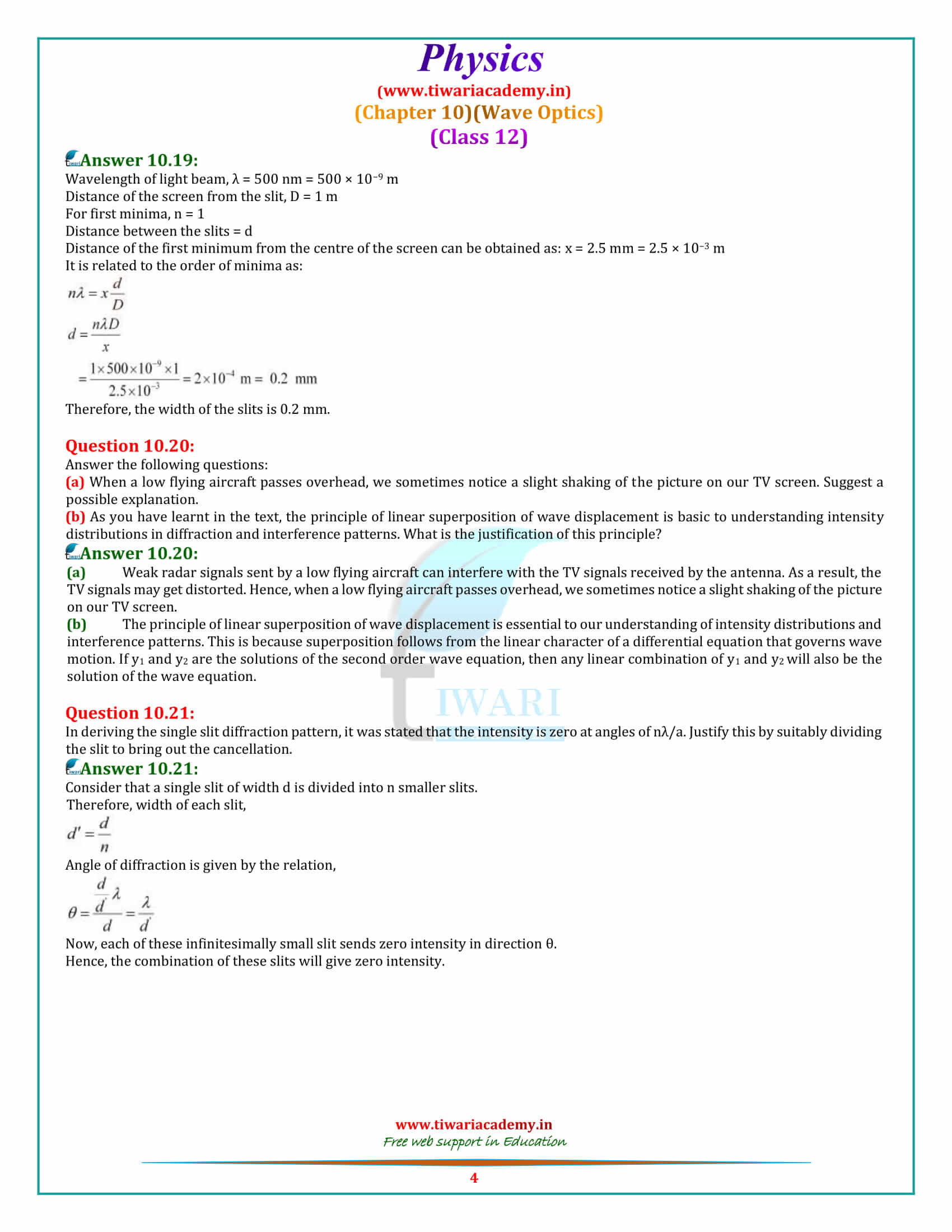NCERT Solutions for Class 12 Physics Chapter 10 Wave Optics in English and Hindi Medium updated for new academic session 2024-25. The solutions of class 12 Physics ch. 10 is revised and modified on the basis of new textbooks published for 2024-25 examination.
NCERT Solutions for Class 12 Physics Chapter 10
Chapter 10 Wave Optics Solutions
- Class 12 Physics Chapter 10 Exercises Solutions
- 12th Physics Chapter 10 Additional Exercises (Not in Syllabus)
- Class 12 Physics Chapter 10 Solutions in Hindi
- Class 12 Physics NCERT Book Chapter 10
- Class 12 Physics Revision Book Chapter 10
- Revision Book Answers
- Class 12 Physics Chapter 10 Revision Notes 1
- Class 12 Physics Chapter 10 Revision Notes 2
- Visit to 12th Physics Main Page
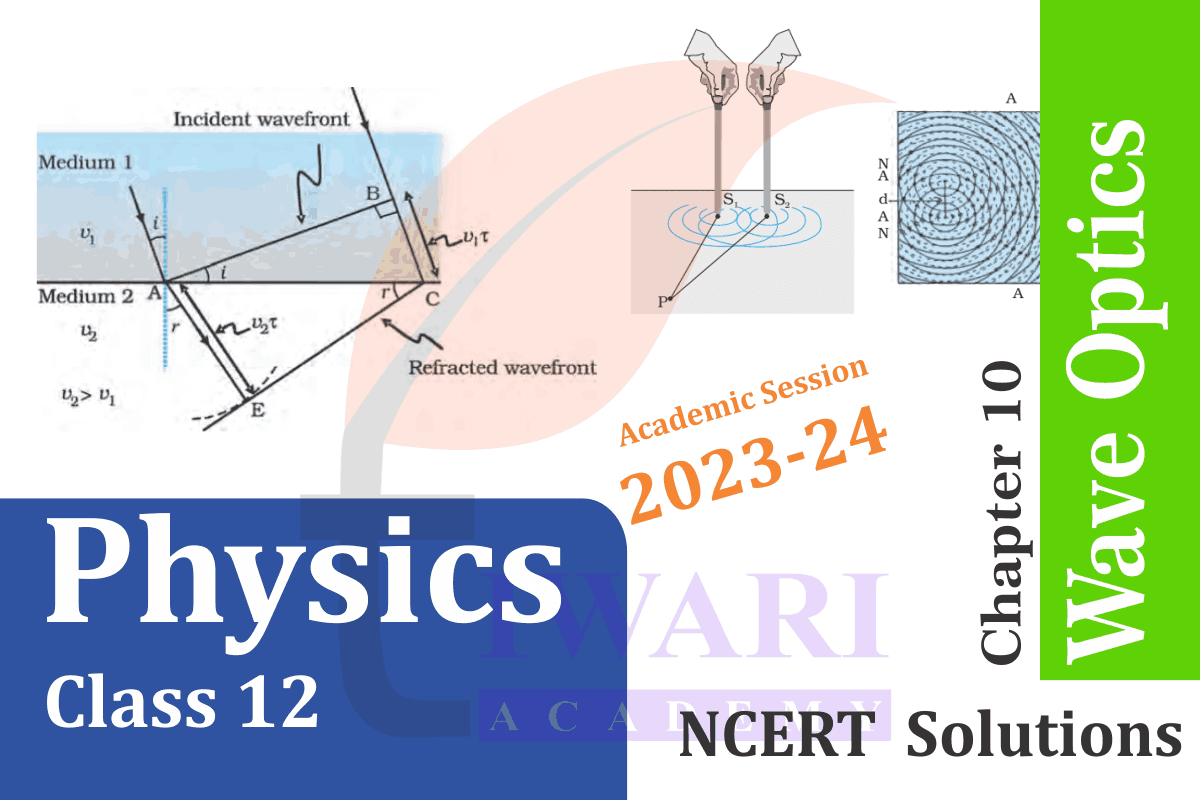
Get here the Chapter end Exercises with solutions and Additional Exercises Solutions in PDF format free download updated for new academic session 2024-25. UP Board Solutions as well as Offline Apps are based on latest NCERT Books issued for 2024-25.
| Class: 12 | Physics |
| Chapter 10: | Wave Optics |
| Content Used: | Exercises and Revision Questions |
| Content Type: | Images, Text, Videos and PDF |
| Academic Session: | Year 2024-25 |
| Medium Used: | English and Hindi |
Class 12 Physics Chapter 10 Solutions in English
NCERT Solutions for Class 12 Physics Chapter 10 in English Medium free to download in PDF form for new session 2024-25. Join the discussion forum to discuss your queries about NIOS board as well as CBSE Board. Download NCERT Books 2024-25 for new session based on latest CBSE Syllabus.

Important Questions for practice
1. A ray of light passes through an equilateral prism in such a manner that the angle of incidence is equal to angle of emergence and each of these angles is equal to 3/4 of angle of prism. Find angle of deviation.
2. Critical angle for a certain wavelength of light in glass is 30°. Calculate the polarizing angle and the angle of refraction in glass corresponding to this.
3. An object of length 2.5cm is placed at a distance of 1.5f from a concave mirror where f is the focal length of the mirror. The length of object is perpendicular to principal axis. Find the size of image. Is the image erect or inverted?
4. A radio can tune into any station of frequency band 7.5 MHz to 10 MHz. Find the corresponding wave length range.
5. Describe an astronomical telescope and derive an expression for its magnifying power using a labelled ray diagram.
Questions from Board Papers
1. Show that maximum intensity in interference pattern is four times the intensity due to each slit if amplitude of light emerging from slits is same.
2. A person looking at a mesh of crossed wire is able to see the vertical wire more distinctly than the horizontal wire. Which defect he is suffering from? How can this defect be corrected?
3. How is a wave front different from a ray? Draw the geometrical shape of the wave fronts when.
(i) light diverges from a point source, (ii) light emerges out of convex lens when a point source is placed at
its focus.
4. Define diffraction. Deduce an expression for fringe width of the central maxima of the diffraction pattern, produced by single slit illuminated with monochromatic light source
5. State the condition under which the phenomenon of diffraction of light takes place. Derive an expression for the width of the central maximum due to diffraction of light at a single slit. Also draw the intensity pattern with angular position.
Important Questions on 12th Physics Chapter 10
Is the speed of light in glass independent of the colour of light? If not, which of the two colours red and violet travels slower in a glass prism?
The speed of light in glass is not independent of the colour of light. The refractive index of a violet component of white light is greater than the refractive index of a red component. Hence, the speed of violet light is less than the speed of red light in glass. Hence, violet light travels slower than red light in a glass prism.
What is the Brewster angle for air to glass transition? (Refractive index of glass = 1.5.)
Refractive index of glass, μ = 1.5 Brewster angle = θ Brewster angle is related to refractive index as: tanθ = μ ⇒ θ = tan⁻¹(1.5) = 56.31° Therefore, the Brewster angle for air to glass transition is 56.31°.
Explain how Corpuscular theory predicts the speed of light in a medium, say, water, to be greater than the speed of light in vacuum. Is the prediction confirmed by experimental determination of the speed of light in water? If not, which alternative picture of light is consistent with experiment?
No; Wave theory Newton’s corpuscular theory of light states that when light corpuscles strike the interface of two media from a rarer (air) to a denser (water) medium, the particles experience forces of attraction normal to the surface. Hence, the normal component of velocity increases while the component along the surface remains unchanged. Hence, we can write the expression: c sini = v sinr … (i) Where, i = Angle of incidence r = Angle of reflection c = Velocity of light in air v = Velocity of light in water We have the relation for relative refractive index of water with respect to air as: μ = v/c Hence, equation (i) reduces to v/c = sini/sinr = μ … (2) But, μ>1 Hence, it can be inferred from equation (ii) that v > c. This is not possible since this prediction is opposite to the experimental results of c > v. The wave picture of light is consistent with the experimental results.
For sound waves, the Doppler formula for frequency shift differs slightly between the two situations: (i) source at rest; observer moving, and (ii) source moving; observer at rest. The exact Doppler formulas for the case of light waves in vacuum are, however, strictly identical for these situations. Explain why this should be so. Would you expect the formulas to be strictly identical for the two situations in case of light travelling in a medium?
No Sound waves can propagate only through a medium. The two given situations are not scientifically identical because the motion of an observer relative to a medium is different in the two situations. Hence, the Doppler formulas for the two situations cannot be the same. In case of light waves, sound can travel in a vacuum. In a vacuum, the above two cases are identical because the speed of light is independent of the motion of the observer and the motion of the source. When light travels in a medium, the above two cases are not identical because the speed of light depends on the wavelength of the medium.
In a single slit diffraction experiment, the width of the slit is made double the original width. How does this affect the size and intensity of the central diffraction band?
In a single slit diffraction experiment, if the width of the slit is made double the original width, then the size of the central diffraction band reduces to half and the intensity of the central diffraction band increases up to four times.
The interference pattern in a double-slit experiment is modulated by diffraction from each slit. The pattern is the result of the interference of the diffracted wave from each slit.
When a tiny circular obstacle is placed in the path of light from a distant source, a bright spot is seen at the centre of the shadow of the obstacle. Explain why?
When a tiny circular obstacle is placed in the path of light from a distant source, a bright spot is seen at the centre of the shadow of the obstacle. This is because light waves are diffracted from the edge of the circular obstacle, which interferes constructively at the centre of the shadow. This constructive interference produces a bright spot.
Two students are separated by a 7 m partition wall in a room 10 m high. If both light and sound waves can bend around obstacles, how is it that the students are unable to see each other even though they can converse easily.
Bending of waves by obstacles by a large angle is possible when the size of the obstacle is comparable to the wavelength of the waves. On the one hand, the wavelength of the light waves is too small in comparison to the size of the obstacle. Thus, the diffraction angle will be very small. Hence, the students are unable to see each other. On the other hand, the size of the wall is comparable to the wavelength of the sound waves. Thus, the bending of the waves takes place at a large angle. Hence, the students are able to hear each other.
Ray optics is based on the assumption that light travels in a straight line. Diffraction effects (observed when light propagates through small apertures/slits or around small obstacles) disprove this assumption. Yet the ray optics assumption is so commonly used in understanding location and several other properties of images in optical instruments. What is the justification?
The justification is that in ordinary optical instruments, the size of the aperture involved is much larger than the wavelength of the light used.
When a low flying aircraft passes overhead, we sometimes notice a slight shaking of the picture on our TV screen. Suggest a possible explanation.
Weak radar signals sent by a low flying aircraft can interfere with the TV signals received by the antenna. As a result, the TV signals may get distorted. Hence, when a low flying aircraft passes overhead, we sometimes notice a slight shaking of the picture on our TV screen.
As you have learnt in the text, the principle of linear superposition of wave displacement is basic to understanding intensity distributions in diffraction and interference patterns. What is the justification of this principle?
The principle of linear superposition of wave displacement is essential to our understanding of intensity distributions and interference patterns. This is because superposition follows from the linear character of a differential equation that governs wave motion. If y1 and y2 are the solutions of the second order wave equation, then any linear combination of y1 and y2 will also be the solution of the wave equation.
